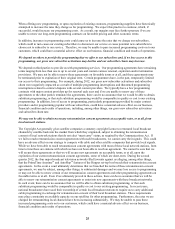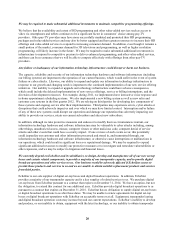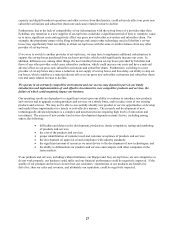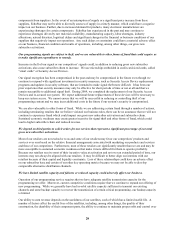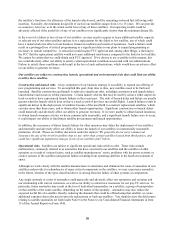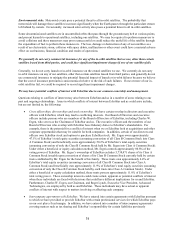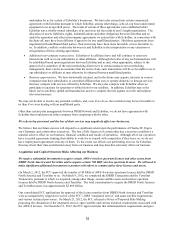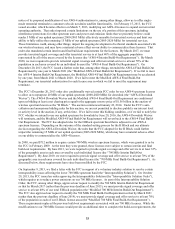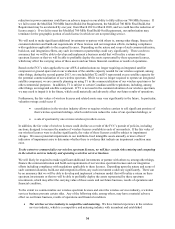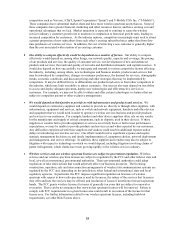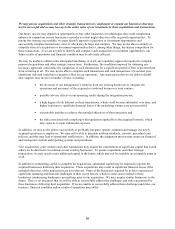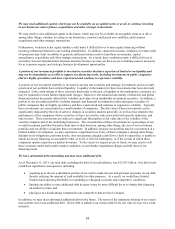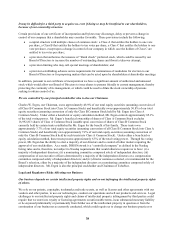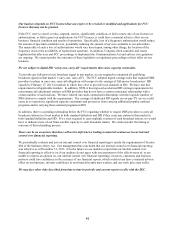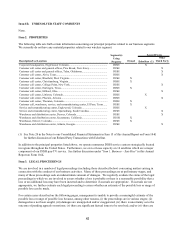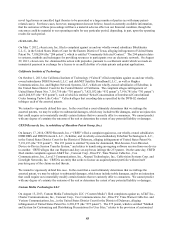Dish Network 2013 Annual Report Download - page 45
Download and view the complete annual report
Please find page 45 of the 2013 Dish Network annual report below. You can navigate through the pages in the report by either clicking on the pages listed below, or by using the keyword search tool below to find specific information within the annual report.35
35
competitors such as Verizon, AT&T, Sprint Corporation (“Sprint”) and T-Mobile USA Inc. (“T-Mobile”).
These companies have substantial market share and have more wireless spectrum assets than us. Some of
these companies have greater financial, marketing and other resources than us, and have existing cost and
operational advantages that we lack. Market saturation is expected to continue to cause the wireless
services industry’s customer growth rate to moderate in comparison to historical growth rates, leading to
increased competition for customers. As the industry matures, competitors increasingly must seek to attract
a greater proportion of new subscribers from each other’s existing subscriber bases rather than from first-
time purchasers of wireless services. In addition, the cost of attracting a new customer is generally higher
than the cost associated with retention of an existing customer.
x Our ability to compete effectively would be dependent on a number of factors. Our ability to compete
effectively would depend on, among other things, our network quality, capacity and coverage; the pricing
of our products and services; the quality of customer service; our development of new and enhanced
products and services; the reach and quality of our sales and distribution channels; and capital resources. It
would also depend on how successfully we anticipate and respond to various competitive factors affecting
the industry, including, among others, new technologies and business models, products and services that
may be introduced by competitors, changes in consumer preferences, the demand for services, demographic
trends, economic conditions, and discount pricing and other strategies that may be implemented by
competitors. It may be difficult for us to differentiate our products and services from other competitors in
the industry, which may limit our ability to attract customers. Our success also may depend on our ability
to access and deploy adequate spectrum, deploy new technologies and offer attractive services to
customers. For example, we may not be able to obtain and offer certain technologies or features that are
subject to competitor patents or other exclusive arrangements.
x We would depend on third parties to provide us with infrastructure and products and services. We
would depend on various key suppliers and vendors to provide us, directly or through other suppliers, with
infrastructure, equipment and services, such as switch and network equipment, handsets and other devices
and equipment that we would need in order to operate a wireless services business and provide products
and services to our customers. For example, handset and other device suppliers often rely on one vendor
for the manufacture and supply of critical components, such as chipsets, used in their devices. If these
suppliers or vendors fail to provide equipment or services on a timely basis or fail to meet performance
expectations, we may be unable to provide products and services as and when expected by our customers.
Any difficulties experienced with these suppliers and vendors could result in additional expense and/or
delays in introducing our wireless services. Our efforts would involve significant expense and require
strategic management decisions on, and timely implementation of, equipment choices, network deployment
and management, and service offerings. In addition, these suppliers and vendors may also be subject to
litigation with respect to technology on which we would depend, including litigation involving claims of
patent infringement, which claims have been growing rapidly in the wireless services industry.
x Wireless services and our wireless spectrum licenses are subject to government regulation. Wireless
services and our wireless spectrum licenses are subject to regulation by the FCC and other federal, state and
local, as well as international, governmental authorities. These governmental authorities could adopt
regulations or take other actions that would adversely affect our business prospects. The licensing,
construction, operation, sale and interconnection arrangements of wireless telecommunications systems are
regulated by the FCC and, depending on the jurisdiction, other federal and international, state and local
regulatory agencies. In particular, the FCC imposes significant regulation on licensees of wireless
spectrum with respect to how radio spectrum is used by licensees, the nature of the services that licensees
may offer and how the services may be offered, and resolution of issues of interference between spectrum
bands. The FCC grants wireless licenses for terms of generally ten years that are subject to renewal or
revocation. There can be no assurances that our wireless spectrum licenses will be renewed. Failure to
comply with FCC requirements in a given license area could result in revocation of the license for that
license area. For further information related to our wireless spectrum licenses, including build-out
requirements, see other Risk Factors above.


